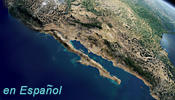![[Ocean Oasis Field Guide]](images/bnr-oo-field.gif)

![[Ocean Oasis Field Guide]](images/bnr-oo-field.gif) |  |
|
Pachycormus discolor ANACARDIACEAE (Sumac Family) | |
|
The generic name refers to pachy for "thick" and kormos for "stump," referring to the thick succulent trunk and lower stems. The specific epithet refers to "dis" or a negation of color. DescriptionThis is an oddly branched tree that grows 3-10 m (9-30 feet) tall. Along the west coast of its range the tree is often stunted and windblown with prostrate trunks. The smooth, grayish-white to yellowish trunk can reach 60-80 cm (24-32 inches) in diameter, and is large in proportion for the height of the tree. The bark of the trunk constantly peels to reveal a smooth blue-green inner bark. The dark green pinnately compound, pubescent leaves emerge from the tree following rains and are up to 8 cm long. The flowers are small and cream to pink in color giving the tree a rosy tinge from a distance. The tree may be found in bloom from May to September. Range and HabitatThe Elephant Tree is most abundant in central deserts and also in the Sierra de La Giganta. The species' range extends south to Cerro Mechudo at the north end of Bahía Madgalena. It is often the dominant plant on lava fields and hillsides. Natural HistoryThere are 2 to 3 subspecies of Pachycormus discolor endemic to the Baja California peninsula, including one that occurs on Magdalena and Margarita Islands and along the west flanks of the Sierra de La Giganta. Pachycormus discolor ssp. veatchiana has small leaves and deep rose flowers. It occurs on Cedros Island and the western section of the Vizcaíno Desert. A white-flowered subspecies of Pachycormus grows on rocky slopes and plains in the Sierra de La Giganta. |

|
Text by Bob Lauri
Photograph by Reid Moran
Field Guide |
Site Index |
Ocean Oasis Introduction
|
|
© 2000 San Diego Natural History Museum |